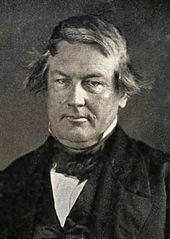The young Millard Fillmore did not have formal education during his formative years because he helped attend their family farm and apprenticed to a cloth maker, who paid him a tiny sum of money. His apprenticeship amounted to little more than slavery; that is why his childhood experience had a considerable impact on Millard Fillmore’s political outlook and stand. In his desperation to leave, he borrowed thirty dollars to buy his freedom from apprenticeship. Millard Fillmore even walked more than a hundred miles back to their family farm.
He displayed a remarkable curiosity and ambition to get out of poverty. Millard Fillmore read as many books as his hands can lay upon to gain an education somehow. Abigail Powers, a well-educated and smart school teacher, became his most significant influence. She was only nineteen when she met Millard and probably the first person to encourage him to be more than just a farmer or a tradesman. She lends her books to him and even challenged him to study difficult subjects.
Later on, Millard’s father, Nathaniel, saw his son’s potential and realized that his son dreamt of becoming a lawyer. He arranged a clerkship for him under Judge Walter Wood. Millard was determined to study and execute the problematic bookwork and taught in a small school to support himself. He courted Abigail Powers, who then became his wife because of his impressive work ethics and aspirations. They were engaged in 1819.
The Millard family moved to East Aurora, near Buffalo, because of their troubled farm. He gained admission to the New York bar in 1823, opened a small law firm, and married Abigal Powers in 1826. Millard Fillmore listened to Abigail’s advice about his career; eventually, he became a prosperous young lawyer. The couple was blessed with two children: Millard, born in 1828, and Mary.
After a man named William Morgan was allegedly kidnapped and never seen again began an exposé of the Masonic organization, it catapulted Millard Fillmore into politics. An Anti-Masonic Party arose against Mason’s political influence. He joined the said party.
Millard Fillmore became a respectable figure despite being not even thirty years old; he was articulate and polished. He was approached to run for the New York state legislature.
Millard Fillmore began his first of three terms in 1829. He concentrated on debtor imprisonment. Considering the poverty he endured and recently escaped, he put his best foot forward to pass the bill he authored in prohibiting the incarceration of those who cannot pay their debts. These policies made him famous to the citizens who paved his way towards the U.S. House of Representatives in 1832.
During his time in the House of Representatives, Andrew Jackson was the current president. Because he disapproved of Andrew Jackson’s leadership, a Democrat, he leaned toward the Whig Party. Thurlow Weed, an Anti-Masonic leader and helped Millard Fillmore ascend the political arena, organized a new party. As Thurlow strongly opposed slavery, he supported a plan which increased Millard Fillmore’s odds of winning.
Millard Fillmore served in the Congress from 1837 until 1843. He was called the chairman of powerful ways and means committee, which mainly dealt with tax and financial issues. In his later years of service in Congress, he oversaw the implementation of a high tariff, which intends to protect the imports.
His political beliefs and outlook aligned with the Whig Party leader, Henry Clay. Both of them believed that a compromise would prevent the slave states from seceding.
Millard Fillmore served his last term in Congress in 1843 for his hope to become the running mate of Henry Clay; however, he was convinced by Thurlow Weed to run for governor in New York. Unfortunately, he did not win and blamed the abolitionists, new Catholic immigrants, and Thurlow Weed.
In 1847, he quickly became a New York comptroller, which became his opportunity to become the Whig Party’s candidate for the 1848 election.
During the 1848 national Whig convention, a war hero of Mexican-American War, Zachary Taylor was nominated to run for president; while Millard Fillmore for vice president. It was primarily endorsed and sponsored by Henry Clay.
President Zachary Taylor unexpectedly died in 1850, which made Millard Fillmore the second man who rises in the office because of sudden death, next to John Tyler. Millard Fillmore took over and attempted to restore political stability.
As the thirteenth president, Millard Fillmore was an anti-slavery moderate, despite personally opposing slavery. He supported the Compromise of 1850, which many historians believed delayed the Civil War. As Millard Fillmore tried to play safe, his policies made him unpopular among the Whigs. He announced his intent to run for another term; however, the Whigs were turned off when he signed the Fugitive State Act, where federal government aid in the capture and return of the runaway slaves to their owners. The Whigs denied his presidential nomination.
He returned to Buffalo and retired from politics. Abigail Powers died in 1853 and married a wealthy widow, Caroline McIntosh, in 1858.
Millard Fillmore died on March 8, 1874, at the age of 74 due to complications following a stroke.
US Presidents | ||

